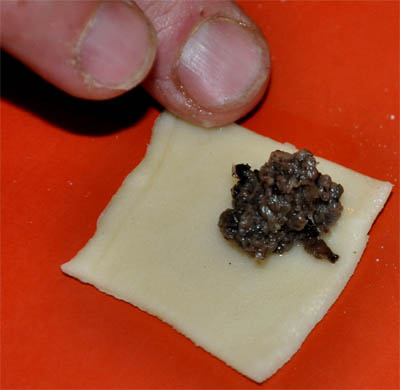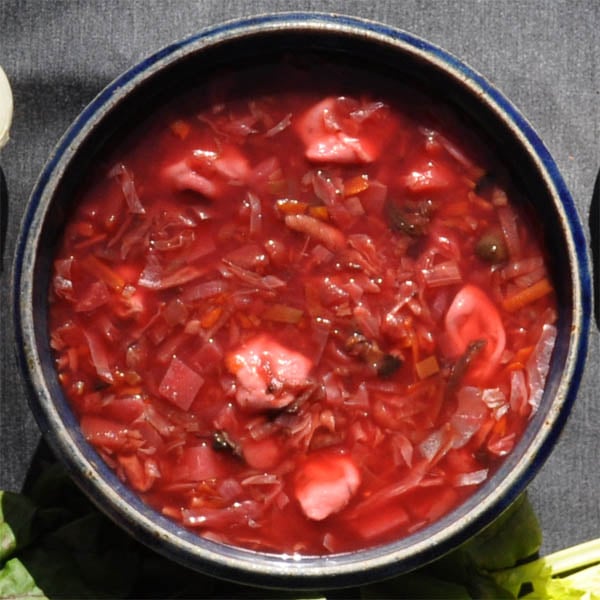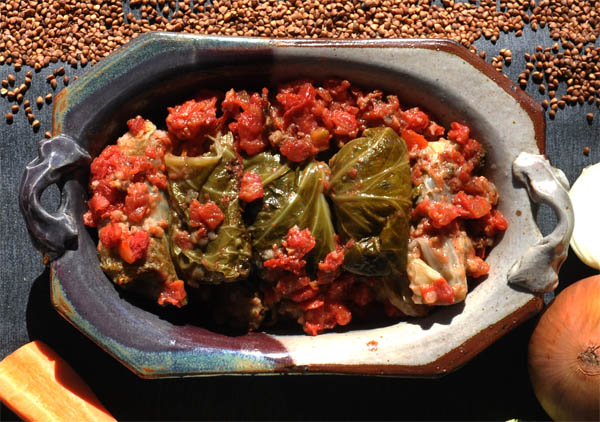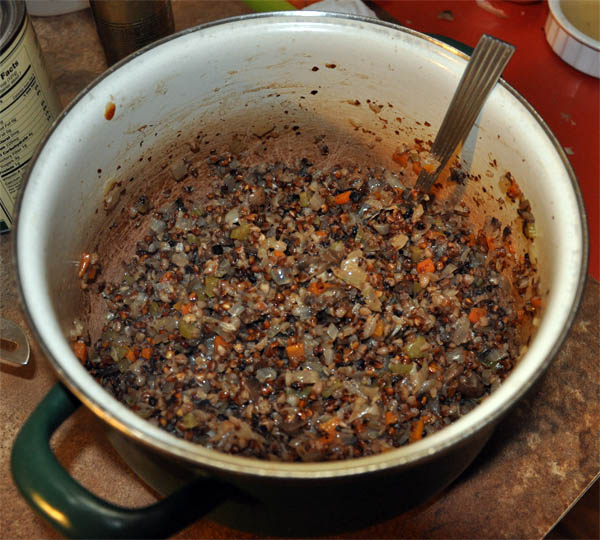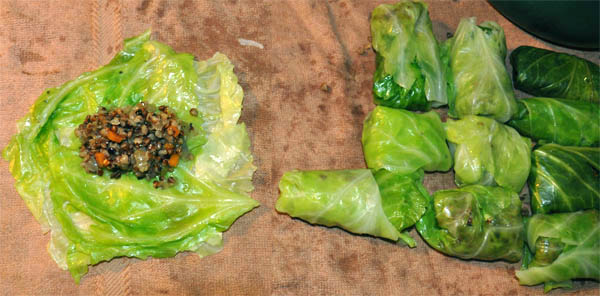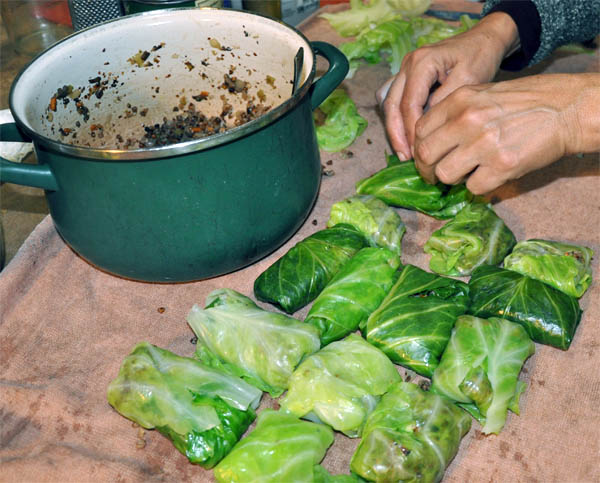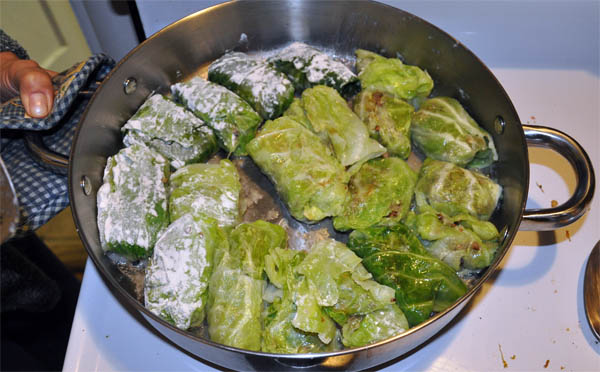We often forget that vegetarian and vegan cuisine is not a new fad, but has deep roots across many different – and sometimes surprising – cultures. The Slavic peoples of central and eastern Europe, with their love of pork, poultry, and sour cream are not generally known for vegetarian, let alone vegan cooking. But the Eastern Orthodox church has many fast-days spread throughout the year in which the devout are required to abstain from eating (non-fish) meats, dairy, and eggs. As a result, these cultures have developed an extensive quasi-vegan diet.
To experience this cooking, let's visit Ukraine on the night of Christmas Eve.

This land, on the edge of the dry steppes of central Asia, was originally covered in grasslands with deep, rich, black soils, much like the prairies of the central USA. Soon after the invention of the plow, these began to be cultivated for a large number of small grains including wheat, rye, barley, and oats. This fertile land soon became the largest grain producer in Europe, supporting one of the densest agrarian populations on the continent. For over a thousand years various empires, including the Vikings, the Poles, the Lithuanians, the Golden Horde, the Cossacks, the Austrians, Tsarist Russia, the Third Reich, and the Soviet Union vied for control of Europe's breadbasket. Often these dominating foreign forces heavily taxed the peasants, taking much of their grain and leaving so little that famine became commonplace. Ukrainians fled west en masse into central Europe and ultimately the New World, searching for a new life. Today it is estimated that 10-20 million people of Ukrainian ancestry live outside of the country. In fact, it is likely that Jeff's own family history is tied to this diaspora: 'Nekola' is not a common or typical Czech surname, and seems likely to be a misspelling of the common Ukrainian given name 'Nikolai', suggesting that his family name may have been brought into the west by serfs fleeing oppression. Of course, ‘Nikolai’ honors Saint Nicholas, the 4th Century Bishop of Myrna (now part of Turkey), who is best known for his secret giving of gifts, such as placing coins in shoes left out over night.
The Ukrainian people are deeply tied to their land. Ukrainian immigrants often took a small vial of soil with them so that they would always have a piece of their homeland with them, no matter where they lived. Farming and the food grown on those farms is a central part of Ukrainian culture and customs, and stretches back to long before Christianity was brought to the region by Vladimir the Great in 988. Perhaps nowhere else are grains and farming so revered, with these ancient traditions being seamlessly incorporated into Orthodox tradition. Even the Ukrainian flag, with the top half being blue and the bottom half yellow, mimics the vast plains of ripe grains stretching to the horizon under an open sky.
Christmas Eve in Ukraine is celebrated in accordance with the Julian Calendar, which falls on the night of January 6 in the western Gregorian Calendar. The day is spent preparing the house for the celebration of the birth of Christ: First the house is cleaned and then instead of a Christmas Tree, sheaves of wheat and rye (called 'didukh' or grandfather) are placed under icons of the Virgin and Child. The holiday table is covered with a white tablecloth, under which is hidden a handful of hay (gathered from the first day of the summer's harvest) and some garlic cloves (to bring good health to the family over the upcoming year). On that table are spread the Holy Supper (Svyata Vechera), which is a Lenten meal consisting of 12 courses, one for each Apostle. One extra place setting is laid out to allow the spirits of the ancestors to also enjoy the feast with the living.
Upon the glimpse of the first star of the evening, the family goes inside, gathers around the table, says a prayer, and enjoys the most sacred meal of the year. First to be tasted, in honor of good harvests and the richness of the land, is Kutia, a sacred Slavic dish of wheat berries, poppy seeds, nuts, dried fruits, and honey. Second, pieces of bread are torn from a braided loaf (kolach) and drizzled with honey. This is followed by a rich vegetarian borscht, stuffed cabbage leaves (holubtsi), filled dumplings (vareniki), assorted sweets, and some fish courses (which are allowed under Orthodox rules, making the meal not fully vegetarian or vegan). However, milk, eggs, butter, cream, and other meats are not to be consumed.
After the meal, neighborhood children gather holding a large wooden Star of Bethlehem lit by a central candle and an enormous sack, and then proceed house to house singing carols and receiving gifts. At midnight, families stream into their local church in their best embroidered clothes for the Christmas service.
Over the next week, we'll show you how to make your own Ukrainian Christmas Eve vegan meal. We've adapted the feast described by Anya von Bremzen and John Welchman in their classic 1990 Russian cookbook “Please to the Table.” Please check it out when you have a chance. Even though we'll limit ourselves to only 5 dishes rather than the traditional 12 (avoiding all fish dishes in the process), you'll still be able to experience a meal that not only celebrates the birth of Christ, but also your garden's harvest and the richness of the land on one of the longest nights of the year.
Kutia celebrates the richness of the land and preceding year's harvest and is only served at Ukrainian religious ceremonies of the greatest importance. While traditionally made with whole wheat berries, it can also be successfully constructed with any number of other cooked whole grains, such as spelt, emmer (farro), or Khorasan wheat (marketed under the trademarked name 'Kamut'). We actually ran out of wheat berries, and used Khorasan wheat when making the batch of Kutia illustrated below. It tasted great.

There is one special piece of equipment that we use when making our Kutia. All recipes call for ground poppy seed, and typically give directions that involve soaking poppy seeds in a hot liquid and then grinding in a food processor or blender. We find this approach simply does not work because the small size of poppy seeds does not allow them to be ground by the spinning blades. We ultimately ordered a hand-cranked poppy seed mill from Lehman Hardware in Dalton, Ohio.The current price is $30, plus shipping, although it is now being sold as a flax-seed mill.

We love the ground poppy seed paste that comes from ours, as the flavor is so much fresher than anything you can get out of a can. Serves 8
1½ dry wheat berries (or other whole grain)
4+ cups water
¾ cup poppy seeds, ground
2/3 cup slivered almonds
½ cup honey
½ cup dry apricots, chopped
½ cup raisins
½ cup dry, tart cherries
ground cinnamon, to taste
Place wheat berries and water into a pot. Bring to a boil, reduce heat to a simmer, and cook over low heat until the wheat is very tender, at least 3 hours. Make sure there is at least 1 inch of water covering the wheat berries at all times. A crock-pot set on low heat works very well for this step.
Grind poppy seeds. Toast slivered almonds on a baking sheet for 3-5 minutes in a 350° F oven until light golden brown.
Drain the cooked wheat, reserving ½ cup of the cooking liquid. Add honey to the reserved liquid and mix well.
Mix all ingredients together and bake uncovered in a 325° F oven for 20 minutes. Remove from oven, cover, and let sit for another 15 minutes. Top with a dusting of ground cinnamon.
May be served either hot or cold.
Part I

An Ukrainian Proverb states: 'Borscht is the center of everything.' It is the Ukrainian national dish and is to be made so thick that a spoon can stand up in it. The name borscht derives from the Old Church Slavonic 'brsh' (beet) in honor of the central ingredient of this stew. While originally a way to extend a handful of vegetables and various leftovers to feed the whole family over a number of cold winter nights, borscht soon evolved into a more extravagant dish loaded up not only with many vegetables but also many types of meat and sausage. There are now as many types of borscht as there are babushkas (grandmothers).
For Christmas Eve, the borscht must follow Orthodox Lenten rules and avoid use of meat, dairy, and eggs. In their place, tiny mushroom-filled dumplings are added to make the stew rich, complex and hearty. Making the tiny dumplings takes a bit of time, so if you want to cut a corner or two, you can eliminate them from the final dish, although it won’t be quite as authentic.
As with all borscht, the flavor will improve as it sits over a few days. If you're not vegan and do not feel obliged to strictly follow Orthodox rules, you should consider serving each bowl with a generous dollop of sour cream on top, which is stirred in at the table to make the borscht even more rich, complex, and luxuriant.
We're going to break this recipe into two parts. Today we'll describe how to make the little dumplings. Tomorrow we'll make the borscht itself.
Tiny Mushroom-filled Dumplings (Vuška)
In Ukrainian ‘vuška’ means ears, and these little filled dumplings do look this way. They also greatly resemble small tortellini. Make them ahead of time and keep in the refrigerator until ready to be put into the borscht

Filling
½ pound mushrooms, coarsely chopped
¼ cup canola oil
1 cup finely chopped onions
½ cup dry, unflavored bread crumbs
salt and pepper, to taste
Heat oil in a small pan over medium heat. Sauté onions until lightly golden, about 10 minutes. Then add in the mushrooms and cook for another 10 minutes until the mushrooms have lost and evaporated their water. Remove from heat and let cool. Put mixture into a food processor and grind into a paste. Add in bread crumbs, season with salt and pepper, and mix well. Set aside.
Dough
1 cup unbleached flour
¼ teaspoon salt
2 tablespoons canola oil
¼ cup water
Mix flour and salt together in a medium-sized bowl. Make a well in the middle of the flour and add in the oil and 1/3 cup water, and mix into the flour with a sturdy spoon, working from the center out. If there is not quite enough water to bring up all the four, add in a little more a tablespoon at a time. Once you have a ball of dough, transfer to a floured surface and knead until smooth, about 2 minutes. Cover and let rest for 30 minutes.
Assembling the Vuška
Roll out the dough very thin, about 1/16 of a inch. Cut into 1 inch squares. Place ¼ teaspoon of mushroom filling near the corner of a dough square. Moisten the edges with a little water, and fold in half along the long axis to make a little triangle. Seal the edges so that the filling won't escape. Bring the opposing corners of the triangle together and pinch to seal. Place on a lightly floured baking sheet. Repeat until all of the dough is used up; you should be able to make at least 50.

These are a bit fiddly to make, and it will be much more enjoyable if you can get a few other people to help make them with you.
Vegetarian Borscht with Little Dumplings
Part II
After making the tiny dumplings in Part 1, we’ll now assemble the borscht. Remember that the flavor will improve with time and that you should let the borscht sit for at least 3 hours before reheating and serving. Better yet, let it rest in the refrigerator over night.Serves at least 8
1/3 cup olive oil
1½ pounds sliced mushrooms
2 large onions, finely chopped
2 large carrots, grated
2 parsnips, thinly sliced
2 leeks, cleaned and finely chopped
3 celery stalks cut into ¼-inch dice
7 medium beets, peeled and grated
1 pound cabbage, shredded
5 potatoes, peeled and cut into ½ inch dice
1 tart apple, peeled and cut into 1 inch dice
6 garlic cloves, coarsely chopped
8 oz tomato paste
3 quarts vegetable stock
2 bay leaves
Tiny mushroom-filled dumplings (optional, though traditionally part of Christmas Eve borscht)
1 tablespoon sweet paprika
2 tablespoon lemon juice (or more to taste)
1 teaspoon sugar or more to taste
salt and pepper (to taste)
2 tablespoons parsley
2 tablespoons dill leaf
Heat oil in a large kettle over medium heat. Add in mushrooms, onions, carrots, parsnips, and leeks and sauté until slightly softened – about 7 minutes. Then add in celery, beet, and cabbage, and continue cooking another 10-15 minutes. Now add the potatoes, apple, garlic, tomato paste and stock. Bring to a boil, reduce to a simmer, add in tiny dumplings (Vuška), and cook (covered) for another 20 minutes.
Add the paprika, sugar, lemon juice, and adjust flavors with salt and pepper.
Let stand at least 2-3 hours (preferably overnight) to let the flavors meld. Reheat and garnish with parsley and dill.
Stuffed Cabbage (Holubtsi)
with Buckwheat and Mushroom Filling
Stuffed vegetables of many sorts are well loved throughout the Slavic countries. One of the most common made is from blanched, stuffed cabbage leaves rolled up like a spring roll and then baked in the oven covered with some type of sauce. While rice-based fillings are perhaps the most widespread, it is also not unusual for them to be made with barley or buckwheat groats. The dark, earthy flavor of buckwheat marries well with mushrooms and is also perfect for our Christmas Eve feast which celebrates the richness of the land.
Buckwheat and Mushroom Filling
¼ cup olive oil, in all
1 cup whole buckwheat groats
2½ cups vegetable stock
2 large onions, finely diced
10 ounces mushrooms, cleaned and finely diced
1 medium carrot, finely diced
salt and pepper to taste
Heat 2 tablespoons olive oil in a medium-sized casserole over medium heat. When the oil is hot, add in the buckwheat groats and sauté for 4-5 minutes until the buckwheat begins to toast and darken. Add the vegetable stock, salt and pepper, and heat until boiling. Reduce heat, cover, and simmer for 15-20 minutes until all the liquid is absorbed and the buckwheat is expanded and soft.
While the buckwheat is cooking, heat the remaining 2 tablespoons of olive oil in a large skillet over medium heat. Add the onions and sauté until translucent, about 5 minutes. Next add the mushrooms, and continue sautéing for another 10 minutes until the mushrooms have stopped releasing water. Then add in the carrots, and continue cooking for another 10 minutes.
Stir the onion-mushroom-carrot mixture into the cooked buckwheat and bake in a 375° F oven until top is lightly browned, about 20 minutes.
Remove from oven and cool.
Making the Holubtsi
12-18 medium-sized cabbage leaves
3 tablespoons canola oil
¼ cup flour
2 tablespoons olive oil
1 cup vegetable stock
28 oz can crushed tomatoes, with liquid
2 tablespoons apple cider vinegar
1 teaspoon sugar
1 teaspoon dill leaf
1 tablespoon finely chopped parsley
1 bay leaf
salt and pepper to taste
Blanch cabbage leaves in boiling, salted water for about 5 minutes until they have become soft and pliable. Drain and pat dry. With a sharp knife, remove the tough central rib from each leaf.
Divide the stuffing equally among the leaves, placing it in bottom half of each leaf. Fold over both sides, and roll from the bottom up, keeping the ends pressed in firmly as you go.
Heat oil in a large ovenproof skillet or casserole. Toss cabbage rolls in flour and fry cook in hot oil over medium heat in skillet for about 15 minutes, until browned. Add stock and tomatoes and bring to a boil. Stir in remaining ingredients and bake uncovered in a 350° F. oven for about 40 minutes.
The best type of cabbage for holubtsi is a variety that does not have too tight of a head, making it easier to remove the cabbage leaves in one piece. As a result, try one of the cone-head cabbages.
Vareniki with Sauerkraut filling
“Patsuk opened his mouth, stared at the vareniki, and opened his mouth wider still. At that moment, a varenik jumped out of the bowl, splashed into the cream, flipped over and leapt straight up into his mouth. Patsuk opened his mouth again, and another varenik went through the same performance. The only trouble he took was to munch it up and swallow it.”
--- Nikolai Gogol,Christmas Eve
Stuffed dumplings, even the mundane kinds that you must physically put into your mouth, are a passion among Ukrainians. This love is shared by almost all their neighbors, with almost identical foods being made by the Poles (perogi), Siberians (pelmeni), Afghans (aush), and Armenians and Uzbeks (mante). Although there are a wide range of possible fillings, ranging from vegetables to ground meat to fruit, one of the most classic is made with sauerkraut.
Sauerkraut Filling
2 tablespoons olive oil
1 large onion, finely diced
4 ounces chopped mushrooms
3½ cups bagged or fresh (not canned!) sauerkraut, rinsed and squeezed dry
1½ tablespoons tomato paste
2 teaspoons sugar
1/3 cup vegetable stock
Heat oil in a large skillet, and when hot add the onion, and sauté over medium heat for about 15 minutes or until browned. Add the mushrooms and cook until all of their water has been released and cooked away. Turn heat up to medium-high, add sauerkraut, and sauté another 15 minutes, stirring frequently. Add tomato paste, sugar, and stock, reduce heat to low, and simmer for 20 minutes. Remove from heat and cool before using to fill the vareniki.
Vareniki Dough
2 cups unbleached all-purpose flour
½ teaspoon salt
¼ cup canola oil
½ cup water
2 tablespoons olive oil
Mix flour and salt together in a medium-sized bowl. Make a well in the middle of the flour and add in the oil and water, and mix into the flour with a sturdy spoon, working from the center out. If there is not quite enough water to bind up all the four, add in a little more a tablespoon at a time. Once you have a ball of dough, transfer to a floured surface and knead until smooth, about 2 minutes. Cover and let rest for 30 minutes.
Vareniki Assembly
Divide dough in half and shape into two balls. Keeping one covered with a damp towel, roll the other into a very thin (1/16 inch) sheet on a floured surface. Cut into 3-inch squares.
Place a tablespoon of filling in the lower middle of each square, moisten the outer margins with water, and fold along the long axis to make a triangle. Seal the edges carefully so that the filling will not leak out. Place finished vareniki onto a lightly floured sheet. Continue until all the dough has been used up (approximately 50-60 vareniki).
Bring 6 quarts of salted water to a boil, and then reduce heat to medium so that the water is simmering. Carefully place 15-20 vareniki into the water and stir occasionally (and carefully) with a wooden spoon to prevent sticking. The vareniki will rise to the surface when cooked. Carefully remove the cooked vareniki with a slotted spoon and place in a colander to thoroughly drain. Transfer to a deep bowl and toss with olive oil. Repeat until all vareniki are cooked.
Ukrainian Christmas Cake
Half of the 12 dishes that make up a traditional Svyata Vechera are sweets, including cakes, compotes, and cookies. This is not terribly surprising, given the eastern European love of desserts. We've chosen our favorite to share with you: the Christmas Cake. Unlike typical western cakes, this one is made from a yeasted dough, and is perhaps best thought of as a sweet, rich, luscious filled bread.
There are three different fillings that are layered into the cake. We recommend that you make them ahead of time.
Poppy Seed Filling
1 cup fresh ground poppy seed
½ cup water
¼ cup ground almonds
2 tablespoons sugar
2 tablespoons honey
1 teaspoon allspice
Add water to the ground poppy seed paste (fresh-grind your own using a poppy seed mill, as discussed in theKutiarecipe), and bring to a boil in a small saucepan. Cook, stirring frequently, for about 5 minutes, or until it becomes thick. Add in the ground almonds, sugar, and honey and cook for another 2 minutes. Take off heat and mix in allspice. Let cool.
Date Filling
1 pound of date puree
1½ cups of apricot preserves
Stir together in a medium sized bowl.
We use compressed date puree that can be bought in little plastic-wrapped bricks at most Middle Eastern groceries.
Walnut Filling
¾ cup sugar
1 teaspoon vanilla extract
½ pound walnuts, finely chopped
¼ cup honey
Stir together walnuts, sugar and vanilla. Add honey and mix well.
Once you have made the three fillings and have allowed them to cool completely, it is time to make the:
Sweet Yeast Dough
1½ cups warm water
2 packages of dry yeast
¾ cup + 1 tablespoon of sugar
½ teaspoon of salt
2/3 cup canola oil
zest of 1 lemon
4 ½ to 5 cups of flour
In a large bowl combine the water and 1 tablespoon sugar. Allow sugar to dissolve, and then add in the dry yeast. Let stand until foamy, about 10-15 minutes.
Add in the oil, sugar, and lemon zest and salt and mix well, either with an electric mixer or by hand with a whisk. Add the flour one cup at a time and mix with a wooden spoon until a loose dough is formed. Place dough on a floured surface and knead until smooth and elastic, about 10 minutes. Keep the kneading surface lightly floured to keep the dough from sticking. Place dough into a lightly oiled bowl, and turn dough to coat fully. Cover and let rise in a warm, draft-free place about 2 hours or until doubled.
Punch down dough. Divide into 4 equal pieces, and cover. Using a floured rolling pin, take out a single piece of dough and roll into a 9 x 13 inch rectangle. Transfer to a large baking sheet covered with baking parchment. Spread the walnut filling over the dough, leaving a ½ inch border on all 4 sides. Roll out a second piece of dough as before and place on top of the walnut filling. As before. spread the apricot and date filling over the second layer of dough. Roll out the third piece of dough, and as before place it on top of the apricot and date filling. Spread this third layer of dough with the poppy seed filling. Roll out the last piece of dough 1 inch larger on all sides than the previous layers, and place on top of the poppy seed filling. Bend the edges down and press into the border of the lower three layers. Starting on one side, roll the sealed border of dough over on itself, working around all four edges. When finished, crimp the crust border around all four edges.
Cover the cake, and let rise for about 30-45 minutes, or until it just begins to look puffy. Prick the top crust with a fork in a few places to allow steam to escape, and place the cake into a 350° F oven for 50-60 minutes. Remove when the crust is well browned and sounds hollow when tapped. Cool on a rack.
The cake will taste better if allowed to rest for a day in a refrigerator or other cool place. Cut into squares and serve.


